
Anthony the Great, was a Christian monk from Egypt, revered since his death as a saint. He is distinguished from other saints named Anthony such as Anthony of Padua, by various epithets: Saint Anthony, Anthony of Egypt, Anthony the Abbot, Anthony of the Desert, Anthony the Anchorite, Anthony the Hermit, and Anthony of Thebes. For his importance among the Desert Fathers and to all later Christian monasticism, he is also known as the Father of All Monks. His feast day is celebrated on 17 January among the Orthodox and Catholic churches and on Tobi 22 in the Coptic calendar.
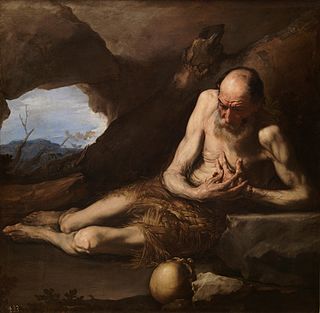
Paul of Thebes, commonly known as Paul the First Hermit or Paul the Anchorite, was an Egyptian saint regarded as the first Christian hermit, who was claimed to have lived alone in the desert of Thebes, Egypt from the age of sixteen to the age of one hundred and thirteen years old. He was canonized in 491 by Pope Gelasius I, and is venerated as a saint by the Catholic Church, Eastern Orthodox Church, and Oriental Orthodox Churches.

Anthony of Kiev also called Anthony of the Caves was a monk and the founder of the monastic tradition in Kievan Rus'. Together with Theodosius of Kiev, he co-founded the Kiev Pechersk Lavra.

Joseph Volokolamsk Monastery is a monastery for men, located 17 km northeast of Volokolamsk, Moscow Oblast. In the 15th and 16th century, it rivaled the Trinity as the most authoritative and wealthy monastery in Russia. It was frequently referred to as lavra, although there was no official corroboration of that status.
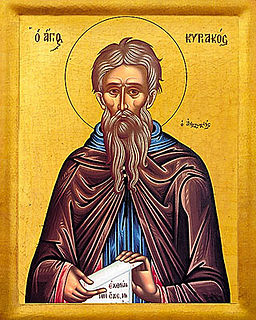
Saint Kyriakos the Anchorite was born in Corinth in the year 448.
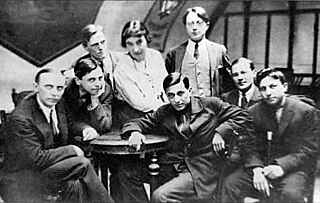
Mikhail Leonidovich Slonimsky was a Soviet writer, member of the Serapion Brothers group.

The Monastery of Saint Macarius The Great also known as Dayr Aba Maqār is a Coptic Orthodox monastery located in Wadi El Natrun, Beheira Governorate, about 92 km (57 mi) north-west of Cairo, and off the highway between Cairo and Alexandria.

Saint Joseph the Hymnographer was a Greek monk of the ninth century. He is one of the greatest liturgical poets and hymnographers of the Eastern Orthodox Church. He is also known for his confession of the Orthodox Faith in opposition to Iconoclasm.
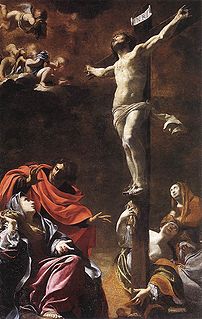
Mara bar Serapion was a Stoic philosopher from the Roman province of Syria. He is noted for a letter he wrote in Aramaic to his son, who was named Serapion. The letter was composed sometime after 73 AD but before the 3rd century, and most scholars date it to shortly after 73 AD during the first century. The letter may be an early non-Christian reference to the crucifixion of Jesus.

The Zarzma Monastery of Transfiguration is a medieval Orthodox Christian monastery located at the village of Zarzma in Samtskhe-Javakheti region, southwest Georgia.
Serapion was Archbishop of Novgorod the Great and Pskov from 1506 to 1509. He is a saint of the Russian Orthodox Church; his feast day is March 16 by the Julian calendar.
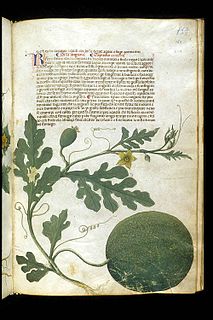
Serapion the Younger was the author of a medicinal-botany book entitled The Book of Simple Medicaments. The book is dated to the 12th or 13th century. He is called "the Younger" to distinguish him from Serapion the Elder, aka Yahya ibn Sarafyun, an earlier medical writer with whom he was often confused. Serapion the Younger's Simple Medicaments was likely written in Arabic, but no Arabic copy survives, and there is no record of a knowledge of the book among medieval Arabic authors. The book was translated to Latin in the late 13th century and was widely circulated in late medieval Latin medical circles. Portions of the Latin text make a good match with portions of a surviving Arabic text Kitab al-adwiya al-mufrada attributed to Ibn Wafid. The entire Latin text is very heavily reliant on medieval Arabic medicinal literature; and it is essentially just a compilation of such literature. It is exceedingly clear that the book was not originally written in a Latin language.

The Serapion Brethren is the name of a literary and social circle, formed in Berlin in 1818 by the German romantic writer E. T. A. Hoffmann and several of his friends. The Serapion Brethren also is the title of a four-volume collection of Hoffmann's novellas and fairytales that appeared in 1819, 1820, and 1821.
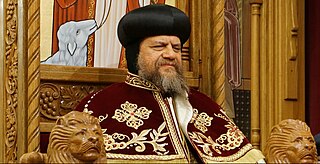
Serapion is the first hierarch and bishop of the Coptic Orthodox Diocese of Los Angeles, Southern California, and Hawaii. He was born in Assiut, Kingdom of Egypt on November 10, 1951. Following his graduation from the Faculty of Medicine at Assiut in 1975, he practiced medicine in Aswan before becoming a monk.

Elizaveta Grigorevna Polonskaya, born Movshenson (Russian: Мовшенсо́н; June 26 [O.S. June 14] 1890 – January 11, 1969), was a Russian Jewish poet, translator, and journalist, the only female member of the Serapion Brothers.
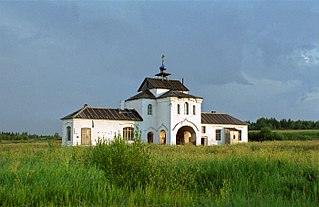
The Kozheozersky Monastery is a Russian Orthodox monastery founded by Niphont of Kozheozero and Serapion of Kozheozero in the 1550s. The monastery is located on a peninsula in Lake Kozhozero, in Onezhsky District in the north-west of Arkhangelsk Oblast, Russia. Kozheozersky Monastery is one of the most remote monasteries in Russia; there are no roads leading to Kozhozero, and the only way to get to the monastery is by traversing 30 kilometres (19 mi) on foot.

Mara bar Serapion was a Syriac Stoic philosopher in the Roman province of Syria. He is only known from a letter he wrote in Syriac to his son, who was named Serapion, which refers to the execution of "the wise king of the Jews” and may be an early non-Christian reference to Jesus of Nazareth.
Blessed Serapion of Vladimir was a bishop of Vladimir. He was Archimandrite of the Kiev Monastery of the Caves from 1247 until 1274, and was bishop of the diocese of Vladimir, Suzdal and Nizhny Novgorod from 1274 until his death the following year. The territory of the diocese at the time consisted of the Grand Duchy of Vladimir and the principalities of Gorodets, Kostroma, Moscow, Pereslavl, Starodub, Suzdal, Nizhny Novgorod and Yuriev.
The Coptic Orthodox Diocese of Los Angeles, Southern California and Hawaii, is a diocese of the Coptic Orthodox Church, which was founded in 1995. It is currently headed by Metropolitan Serapion the bishop of Los Angeles, and Metropolitan of Southern California and Hawaii.
Serapion of Nitria or Serapion of Thmuis was an early Christian monk in Nitria, Lower Egypt, born in the third century AD. He was a companion of Anthony the Great, the abbot of the Monastery of Arsina in Nitria, and the bishop of Thmuis. His feast day in March 21 in the Orthodox Church.
















